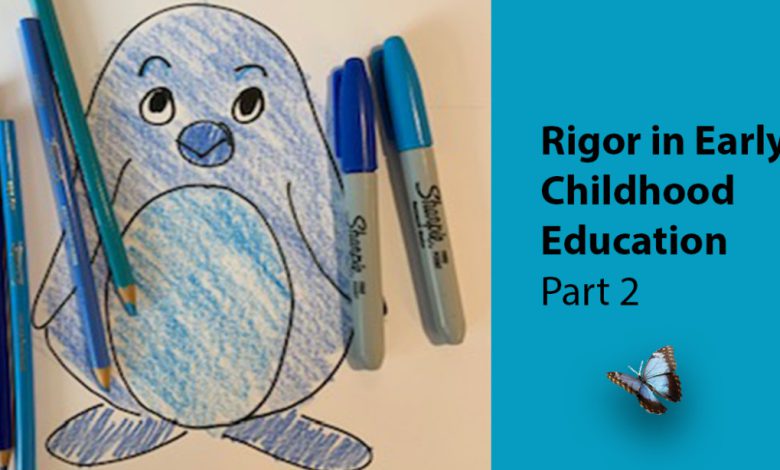Rigor, Relevancy, and Blue Penguins in Early Childhood Classrooms

This is the second post in our Rigor in Early Childhood Education series for teachers and administrators. To read Part 1, click here.
Earlier this month, my colleague Beth White authored Part 1 of this two-part series on “Rigor in Early Childhood Education Classrooms.” As a former kindergarten teacher myself, I was particularly intrigued by the observations she documented from a kindergarten classroom. Of the many thoughtful takeaways Beth provided, her focus on relevancy is where I’d like to pick up.
Previously, I’ve written about the connections between relevancy with social-emotional development in response to a report from the Education Trust, which concluded that “students rarely receive relevant assignments that allow room for student choice, potentially jeopardizing their engagement.” My reaction to this report is the same now as it was then, “no kidding!” The idea that something being learned or taught ought to be relevant to the student or teacher is certainly not a new concept.
The Effect of Relationships on Approaches to Learning
While there is a great deal written in the education community about the importance of social-emotional development, the report mentioned above made me think of the important overlap between social-emotional development and another essential area of development for young children: their approaches to learning, both important areas in consideration of rigorous, relevant, and appropriate instruction as these two areas overlap in important ways that make learning more relevant and engaging to children.
Considering the effect that relationships have on children’s social-emotional development and the effect that social-emotional development has on all other areas of learning, the relationships forged in an early learning environment create an important context for overall learning and engagement. These relationships form the center of social and emotional learning competencies, which in turn are closely related to the cognitive capabilities that shape children’s approaches to learning. For instance, when children are able to take on the perspective of others, they are in a better position to consider diverse and divergent viewpoints for the purpose of effective problem-solving.
As noted above, engagement is an indispensable component of children’s approaches to learning. Without question, children who are deeply engaged in classroom activities are more apt to persist when making mistakes, to play or tinker with ideas to create new solutions to problems, and to assist peers in solving problems. In turn, this engagement creates an emotional commitment to the work they are completing and to the people they are completing it with. Consistent engagement depends on children’s cognitive ability to implement coherent problem-solving strategies and also requires children to support one another and develop peer relationships, which are essential elements to programs that support rigorous learning experiences.
Observing Classrooms with an Eye Towards Rigor
As my colleague, Beth implored administrators to do in her post, “Ask yourself: What about this activity/interaction/learning experience I am seeing either supports the development of or represents current levels of children’s cognition?” This is an essential question for administrators who not only want to ensure that instruction is rigorous and relevant but who also want to ensure an adherence to instruction that is developmentally appropriate and representative of the whole child.
However, since many administrators, particularly in public school settings, do not have a background in early learning, this can be a challenge. Gathering resources, such as those that help to define learning trajectories for young children as well as the principles for Developmentally Appropriate Practice (DAP) help an administrator tint their observational lens with an early childhood perspective. Knowing about child development and learning is not only a cornerstone to practices that are DAP, but necessary to ensuring that rigorous practices are appropriate, worthy, and equitable, which brings us to the blue penguin that Beth referenced in her post.
While the kindergarten child found meaning and relevance to an activity seemingly devoid of either, we’re left wondering why such an activity (i.e., whole group coloring of a penguin worksheet, in May!) was occurring in the first place. If an administrator, coach, or colleague were to observe this activity, what suggestions could be given to improve the rigor and relevance in this particular classroom?
What rigor should look like to an educator observing a kindergarten class is a classroom filled with children deeply engaged in meaningful activities and projects. Some children will be making mistakes, some children will be assisting peers, and all children will have the opportunity to play with ideas. In short, guided play is an important instructional strategy to facilitate deep engagement.
Yes, even in kindergarten classrooms, integrating guided play and structuring experiences for children in a variety of centers or interest areas (e.g., the block and discovery areas) provides many opportunities to deepen learning opportunities for young children and allow for teachers to gauge child perspectives on a variety of topics (e.g., when might you observe a penguin that is blue?). Children ought to have the same freedom to tinker, test, and experiment with ideas that any thoughtful adult experiences when the solution to a problem is novel and derived only by playing with a multitude of ideas.
While the quest for rigorous instruction is necessary and appropriate for each and every child, let’s not forget that the objective must be relevant to the child and worthy of doing in the first place.





